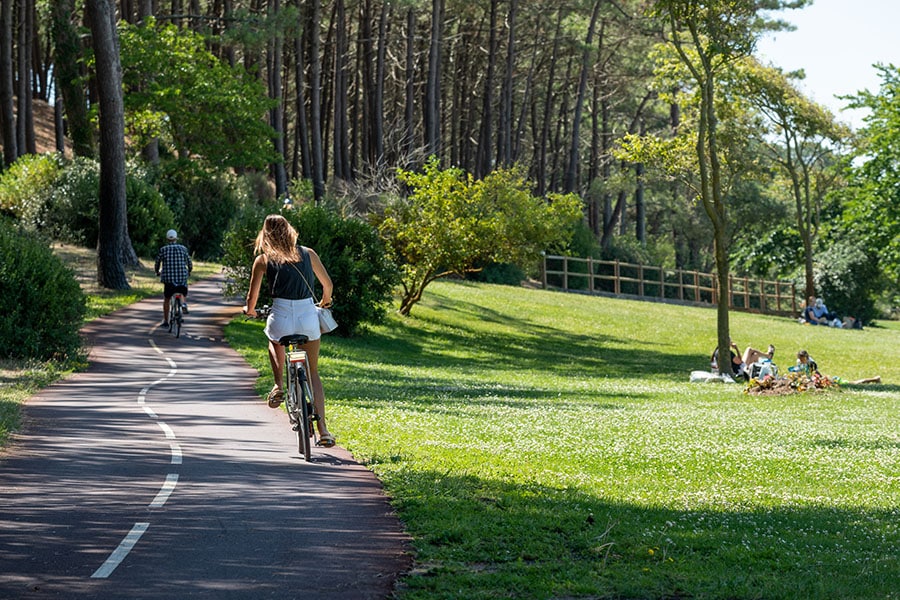More and more people are using bicycles as a means of transportation. We can attribute this to increasing concerns about the environmental impacts of automobiles, a desire to maintain physical fitness, and congestion in large cities, among other reasons.
Due to increased bicycle usage for both recreation and commuting, it is even more critical that government agencies design and maintain adequate bicycle facilities. This includes the Federal Highway Administration to your local parks department.
Below we will highlight some bike path options and factors that impact your final bike path designs, explain multi-use trail options, and provide some project considerations.
Deciding Between a Bike Path or a Multi-Use Trail
As you plan your next project to expand bicycling access in your community, one of the first questions you need to answer is whether a multi-use or bicycle-only path would best serve your constituents. This answer will depend on various factors, including your project goals and available resources.
The fewer users you expect on your path, the more sense a mixed-use trail would make. If you are expecting significant traffic on your pathway, developing a designated bike path will best serve your constituents if you are expecting substantial traffic on your route. Depending on your goal and existing infrastructure, this could run parallel to an existing walkway or roadway.
Another option is to create a bike lane design on an existing road or pathway if space permits. A solid white line separates the bicycle lane from the vehicle traffic or pedestrians in this design.
What are Best Practices for Designing Walkways?
Many parks around the United States utilize mixed-use trails that can effectively accommodate pedestrians and cyclists. Not every path should allow for multiple uses, however.
Guidance from the American Association of State Highways and Transportation Officials says that multi-use trails should be a minimum of eight feet wide. Those with heavy usage should extend at least 12 feet. The more traffic from both user groups you expect on the bike path for your locality, the more separation options your department should consider.
What about Horse Trails?
Depending on the environment and the community, allowing horses on the same path as pedestrians and bicycles can work. If many horse riders plan to utilize the pathway, the equestrians should have their own trail. However, if only a few horses are expected and the path itself won’t be a high traffic area, having all three groups on the same path can work.
Of course, the tread requirements for bikes and horses are different, which means that separate trails will require multiple surface materials. The load-bearing capability of the pathway is another important consideration for horse trails. With a stable geogrid solution like PaveCore and BaseCore Geocell, your pathway can easily support each user group.
Surface Options
Your choice of surface material will impact your bike path’s acceptance, accessibility, and lifespan. Pavement or asphalt is the best surface choice for trails intended for longer-distance riders.
Depending on your budget and project goals, there are a variety of surface options, including:
- Asphalt
- Crushed Stone
- Soil Cement
- Natural Earth
- Concrete
No matter the surface material, designing a high-quality, durable foundation will allow the trail to serve its users better. Utilizing a geogrid like PaveCore and BaseCore Geocell to shore up unstable portions of your trail or to support the entire thing can help you improve your project’s lifespan and quality.
Factors that Influence Your Bicycle Path Design
Even once you have your project goal established, many other factors will guide the final design for your bike path.
Budget
One of the most important considerations is the budget you have at your disposal. Many grants help parks departments and non-profits create their ideal trails and paths.
The more practical and accessible the trail, the easier it will be to find ancillary funding.
User Groups
What user groups will utilize your trail? Can each of those groups use the same tread on the same trail, or do you need to design different surfaces? Do those sections need to be separated, or should they be on entirely different tracks?
Environment and Available Area
What area is available for the project? Is there a right-of-way that your department can utilize? What constraints does the available land put on the project scope or type? Will the trail require retaining walls or other slope supports?
These are essential questions to consider as you plan your bike path project.
Environmental Impact
Another factor that will affect your design considerations is the environmental impact your trail could have. Your pathway could negatively influence the local ecosystem or contribute to a heat island if you don’t design it intentionally.
A Reliable Foundations for Bike Paths and Other Trails
With PaveCore and BaseCore Geocell, you can design reliable and economical bike pathways, horse trails, and walkways in your community. Whether you’re looking to develop an entire bike trail from scratch or need to stabilize an existing problem area, our engineers can walk you through how PaveCore and BaseCore Geocell can improve your bike trail.
We help Parks and Recreation Departments, civil engineers, project managers, and developers worldwide design reliable transportation solutions. Our high-density polyethylene (HDPE) geogrids that can support projects of all sizes and work with numerous infills will provide the perfect foundation for your next project. Consult with our engineers today!
